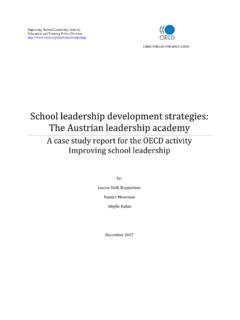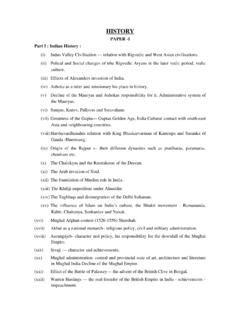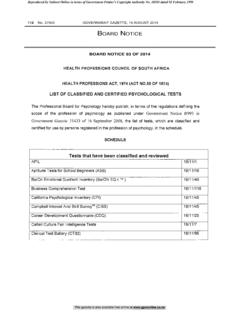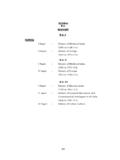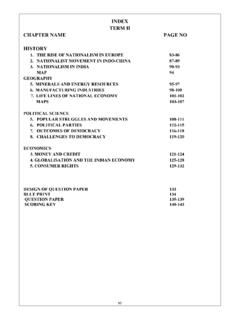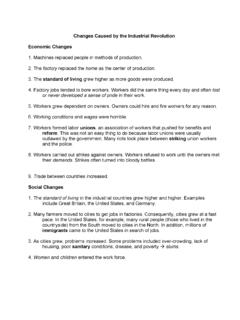Transcription of January 1998 FIELD PEA - WebGrower.com
1 EM 8698 January 199850 FIELD PEA (Pisum sativum L. or Pisum sativum L. ssp. arvense (L.) poir.) R. Sattell, R. Dick, D. Hemphill, and D. McGrathQuick facts: FIELD peaCommon namesField pea, austrian winter peaHardiness zone7 (see Figure 1)pH ; optimum near soil typeWide range with adequate drainageFlood toleranceLowDrought toleranceModerateShade toleranceLowMowing toleranceLowDry matter tons/acreN accumulation100 lb/acreN to following cropHalf of accumulated NUsesUse as a winter annual cover crop tosmother spring weeds, fix N, and improvesoil tilth. Often grown with cereal killed and incorporated. Will notescape and become a not tolerate wet pea looks very similar togarden pea. It is a climbing annuallegume with weak, viny, and rela-tively succulent stems. Vines oftenare 4 to 5 feet long, but when grownalone, FIELD pea s weak stems preventit from growing more than to2 feet have two leaflets and atendril.
2 Flowers are white, pink, orpurple. Pods carry seeds that arelarge (4,000 seeds/lb), nearly spheri-cal, and white, gray, green, or root system is relatively shallowand small, but well is slow during winter butincreases rapidly in warm preferencesand limitationsField pea requires cool, moistgrowing conditions and can with-stand heavy frost once established. Itdoes not grow well in hot weatherand is not suitable as a summer covercrop. Germination occurs at tempera-tures as low as 40 F, althoughoptimal temperatures for germinationand growth are between 60 and 70 pea grows well on a widerange of soils; however, waterloggedsoils and temporary flooding are nottolerated. FIELD pea prefers well-limed soils with a pH near , but isreported to tolerate soil pH as low and as high as pea is not shade-tolerant andshows little salinity in the WillametteValley have shown that FIELD peastands were more erratic and lessvigorous than other vetches andclovers tested.
3 This poorerperformance may be due in part tofield pea s low tolerance for water-logged soils or its susceptibility towater-associated root pea can be used as a covercrop, green manure, forage, hay, andsilage. Hay is good quality, but pea ismore succulent than vetches andmore difficult to cure. Regrowth aftermowing or grazing is grown alone and incorpo-rated or killed in spring, FIELD pearesidues decompose rapidly and cancontribute nitrogen (N) to a followingcrop. FIELD pea has no hard seeds, iseasy to kill, and does not escape tobecome a pea often is planted inmixtures with cereal grains. Thecereal protects the soil during winter,when FIELD pea growth is slow, andprovides a support for vines to climb,keeping pea vegetation off theground where it is more likely to spring FIELD pea growthsuppresses springweeds andreduces theoverall C:N ratioof spring resi-dues, speedingthe decomposi-tion process andpreventingcompetition bysoil microbes forplant-available pea is nota good choice forrelay interplant-ing.
4 It is not likelyto withstandharvest traffic, nor is it able toemerge from heavy harvest matter and N accumulationIn a mid-Willamette Valley repli-cated trial over 5 years, Austrianwinter pea planted in mid-Septemberaccumulated a maximum of ,minimum of , and average tons dry matter/acre and amaximum of 202, minimum of 28,and average of 104 lb N/acre by fall planting generally ispreferred because larger overwinter-ing plants are more winter-hardy,provide more soil protection, and arebetter able to withstand insectdamage in the spring. However,warmer temperatures in early fall alsoincrease seedling susceptibility to soilpathogens. FIELD peas planted in latefall do not grow to appreciable sizeuntil spring and are more prone towinter-kill by cold or seeding rates vary from70 160 lb/acre. Increase seeding ratesfor larger seeds, later plantings, or ifplanting into rough , drill seed into a smoothseedbed to a depth of 1 to 2 seeds deeply if necessary toreach available moisture in non-irrigated soils, and shallowly inirrigated soils or if fall rains havebegun.
5 You can broadcast seed, butthe plants will be vulnerable tolodging and rotting if not plantedwith a nurse crop. It s best to tilllightly after broadcasting to put theseed below the pea roots need to becolonized by an appropriate strain ofrhizobia bacteria to be able toconvert atmospheric nitrogen intoplant-available forms. Inoculatingseed with the proper rhizobiabacteria ensures that the bacteria willbe present when the seed fresh inoculant, protect it fromheat and light, and apply it to seedsjust before planting according to themanufacturer s directions. Coverbroadcast seed with soil to protectinoculant from may not need to inoculate ifthe appropriate rhizobia bacteriaalready are present in the soil. Youcan find out by planting a section ofthe FIELD with raw (non-inoculated)seed and watching for differences pea normally is killed orincorporated in spring at thebeginning of bloom. When grownalone, succulent residues are incor-porated easily with a disk anddecompose very rapidly, releasingaccumulated N for use by the follow-ing interactionsIncorporating succulent FIELD pearesidues often causes a sharpincrease in soil-borne pathogenpopulations, especially damping offfungi ( , pythium).
6 If susceptibleseed is planted shortly after incorpo-ration, you may have more problemswith this disease. Avoid this problemby waiting several weeks betweenresidue incorporation and planting,and by ensuring that soil temperatureand seedbed preparation are optimalfor rapid seedling peas are not an appropriatecover crop to grow in rotation with acash crop legume because they aresusceptible to many of the samediseases, allowing pathogen popula-tions to grow pea harbors high densities ofaphids and aphid predators such assyrphid flies and seven-spotted ladybeetles. FIELD pea flowers attract beesand native used as a break crop, fieldpea can reduce the incidence of take-all in , FIELD pea does not growenough in the fall to out-competeand reduce weeds and is a poorcompetitor in areas with abundantwinter weed generally is available on ageneric basis as FIELD or Austrianwinter more informationWorld Wide WebOrchard floor management informa-tion Extension Service publications University of California, Daviscover crop information Cover Crop HandbookThis publication also is part of UsingCover Crops in Oregon, EM 8704, whichcontains an overview of cover crop usageand descriptions of 13 individual covercrops.
7 To order copies of EM 8704, sendyour request and $ per copy to:Publication OrdersExtension & Station CommunicationsOregon State University422 Kerr AdministrationCorvallis, OR 97331-2119 Fax: 541-737-0817 Funding for this project was provided by the Oregon Department of publication was produced and distributed in furtherance of the Acts of Congress of May 8 andJune 30, 1914. Extension work is a cooperative program of Oregon State University, the of Agriculture, and Oregon counties. Oregon State University Extension Service offerseducational programs, activities, and materials without regard to race, color, religion, sex, sexualorientation, national origin, age, marital status, disability, and disabled veteran or Vietnam-eraveteran status as required by Title VI of the Civil Rights Act of 1964, Title IX of the EducationAmendments of 1972, and Section 504 of the Rehabilitation Act of 1973. Oregon State UniversityExtension Service is an Equal Opportunity Sattell, faculty research assistant in crop and soil science; Richard Dick, professor of soilscience; Delbert Hemphill, professor of agriculture; and Dan McGrath, Extension agent,Willamette Valley; Oregon State University.
8 1998 Oregon State University. This publication may be photocopied orreprinted in its entirety for noncommercial 1. Oregon plant hardiness zonemap. FIELD pea normally will survive inZone 7 or any warmer zone. (Extractedfrom the USDA s national plant hardinesszone map, based on average annualminimum temperature in F.)Zone 4 = -30 to -20; Zone 5 = -20 to -10 Zone 6 = -10 to 0; Zone 7 = 0 to 10 Zone 8 = 10 to 20; Zone 9 = 20 to 30

